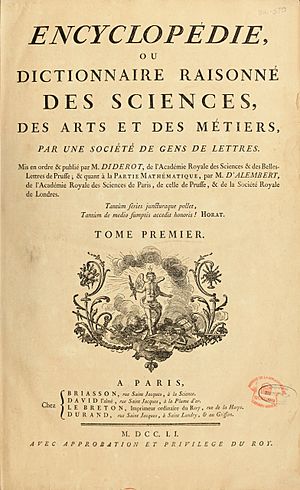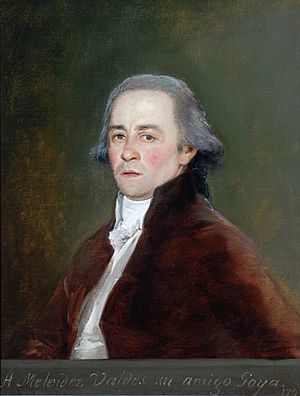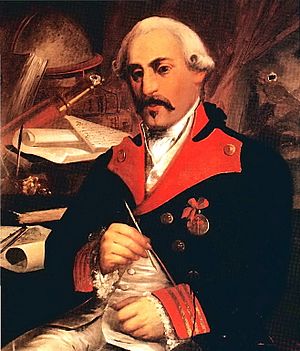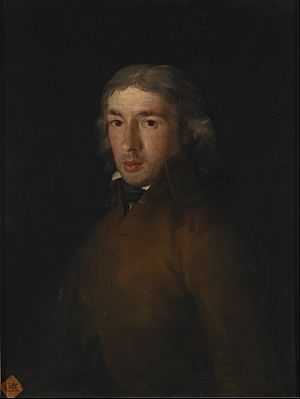Spanish Enlightenment literature facts for kids
Spanish Enlightenment literature is the writing that came out of Spain during the 1700s, a time known as the Age of Enlightenment.
This period brought a new way of thinking. People started to value reason, science, and experience more than old traditions. They believed that culture and progress could lead to human happiness. In art and literature, this meant a move towards a new, simpler style called Neoclassicism. Writers tried to avoid showing too much emotion and followed strict rules to create balanced and harmonious works. Towards the end of the century, people started to miss expressing feelings, which led to a movement called Pre-Romanticism.
Contents
A Look at History
The 1700s in Spain began with the War of the Spanish Succession (1701–1714). European countries were worried about the power of the French King Louis XIV and his grandson, Philip V of Spain, who was set to become the next king of Spain. A group of countries formed an alliance to support another heir, Archduke Charles of Austria.
After the war ended with the Treaty of Utrecht, Philip V (1700–1746) was recognized as King of Spain. However, Spain lost control of Menorca and Gibraltar. Philip V focused on making the government more centralized. He even stepped down for a short time for his son, Louis I, but returned to the throne when Louis died.
After Philip V, Ferdinand VI (1746–1759) became king. He worked to improve roads and communication in the country. He also supported the growth of sciences.
Then came Charles III, Ferdinand VI's half-brother. He was a great example of an enlightened monarch. He had smart ministers who helped him modernize Spain. They improved education, trade, and public works, even though they kept the old system of government.
During the rule of Charles IV, the French Revolution began in 1789. Because Charles IV was a weak ruler and his minister, Manuel Godoy, was too ambitious, Charles had to give up his throne to his son, Ferdinand VII. This happened after the French invaded Spain in 1808.
The Enlightenment in Europe

Towards the end of the 1600s, the old way of life in Europe, where church leaders, soldiers, and nobles had most of the power, started to change. In the 1700s, Europe began to question everything. People believed that reason was the best way to gain knowledge. They promoted experiments and studies based on logic, rather than just accepting what authorities said.
Learning moved from royal courts to public places like salons, cafes, and cultural centers. People felt the need to travel, learn new languages, and improve their lives.
Enlightened thinkers were often philanthropists, meaning they cared about others. They suggested and carried out reforms in culture and society. They believed in religious tolerance and questioned traditional beliefs. Thinkers like Montesquieu argued for separating government powers (legislative, executive, judicial). The enlightened wanted freedom and the right to choose their leaders. These ideas inspired the famous motto of the French Revolution: "Freedom, Equality, Fraternity."
The Enlightenment started in England but became very strong in France. Its ideas were collected in a huge book called the Encyclopédie (1751–1772). This book, edited by Jean Le Rond d'Alembert and Denis Diderot, aimed to gather all the knowledge of their time in one place.
The Enlightenment in Spain
Early Reformers: The Novatores
During the time of the Habsburg kings, Spain didn't focus much on science. Scientific studies were often viewed with suspicion and even stopped by the Inquisition. This meant Spain was behind other European countries at the start of the 1700s. However, some smart people from the late 1600s kept researching. They risked a lot to stay updated on European discoveries in astronomy, medicine, math, and plants. These scholars were called novatores (meaning 'innovators'). They helped spread the ideas of scientists like Galileo Galilei and Isaac Newton.
How Enlightenment Ideas Came to Spain
After the War of the Spanish Succession, the new Bourbon kings saw Spain as a country struggling with poverty and lack of knowledge. Spain had only about seven and a half million people. King Philip V, influenced by French politics, made the monarchy stronger and centralized the country. He removed some old laws in Aragón and Catalonia. The Church still had a lot of power, though some religious groups, like the Jesuits, lost influence later under Charles III. Ordinary people, like farmers and workers, had few rights. The kings slowly reduced some privileges of the nobles and became more critical of the Church to make reforms. By the end of the century, life in Spain had improved, and the population grew by almost three million people.
Enlightenment ideas reached Spain in several ways:
- Spanish Thinkers: Ideas were spread by Spanish scholars like Gregorio Mayans and Benito Jerónimo Feijoo, who were part of the novatores group.
- French Books: French Enlightenment ideas from thinkers like Rousseau, Voltaire, and Montesquieu came into Spain. This happened despite censorship and the Inquisition trying to stop them.
- Translations and Teachers: French books were translated, and foreign professors were hired to teach new subjects.
- Travel: Spanish scholars traveled to Europe to study and learn about other cultures.
- Newspapers: Newspapers and other publications helped spread Enlightenment ideas.
- Cultural Groups: Many new cultural groups and economic societies were created. These groups aimed to improve Spain's culture, society, and economy. The first one started in 1765 and soon spread across the country. They were made up of enlightened nobles, middle-class people, and clergy.
Important organizations created during this time include the Royal Spanish Academy, founded in 1713 to improve the Spanish language. Its motto was "it purifies, fixes and shines." The Academy's first big project was the Diccionario de la lengua española (Dictionary of the Spanish Language), published from 1726 to 1739. This dictionary explained the origin of each word and included quotes from famous writers to show how words were used. Other important institutions were the Biblioteca Nacional de España (National Library, 1712), the Real Academia de la Historia (Royal Academy of History, 1736), and the Museo del Prado (Museum of Prado, 1785).
The Enlightenment was strongest in Spain during the reign of Charles III. It began to decline around the time of the French Revolution (1789) and the French invasion of Spain (1808). The reformers, even with the king's support, were not accepted by the privileged groups. Many were called "pro-French" and accused of attacking Spanish traditions and religious education. After the French Revolution, some were even arrested.
Spanish Language in the 1700s
In the 1700s, writers worked to make artistic language clear and natural. They fought against the complicated and artificial style of the late Baroque period.
Latin was still used in universities, but Spanish slowly took its place. Spaniards wanted to bring back the glory of the Golden Age for their literary language. To do this, they needed to develop ways of expressing new scientific ideas in Spanish. Many scholars, like Feijoo and Jovellanos, worked on this. After the War of Independence in 1813, Spanish became the only language used in universities.
Many enlightened people believed that teaching other languages (like French, English, and Italian) was important for modernizing Spain. They also supported translating important foreign works into Spanish. However, some people disagreed. They thought classical languages (Latin and Greek) were more important than modern ones. Others rejected translations, fearing they would bring too many foreign words into Spanish and harm its identity. This led to two main ideas:
- Casticismo: This idea supported a pure Spanish language, without mixing in foreign words or phrases. They wanted to use words found in the Royal Spanish Academy's dictionary.
- Purismo: This was even stricter, completely against any new words, especially foreign ones. They accused others of "dirtying" the language.
Periods of 18th-Century Literature
Spanish literature in the 1700s can be divided into three main periods:
- Anti-baroquism (until about 1750): Writers tried to move away from the complicated and overly decorative style of the late Baroque. They focused more on essays and satire, using simple and pure language. They didn't write much for entertainment.
- Neoclassicism (until the late 1700s): Writers became interested in the classical styles of France and Italy. They also copied ancient Greek and Roman writers. This style was most popular from the reign of Ferdinand VI well into the 1800s.
- Pre-Romanticism (late 1700s and early 1800s): Influenced by thinkers like John Locke and Jean-Jacques Rousseau, people started to feel that reason alone wasn't enough. This movement emphasized the right to express personal emotions, especially love, which Neoclassical writers had held back. Pre-Romanticism marked the end of Neoclassicism and opened the door for the Romantic movement.
Prose Writing
Stories and novels were almost non-existent in Spain during this time. A few examples include Vida, ascendencia, nacimiento, crianza y aventuras del Doctor Don Diego de Torres Villarroel by Diego de Torres Villarroel.
Newspapers became very important. Publications like Diario de los Literatos de España and El Censor helped spread the ideas of the Enlightenment in Spain. They set the stage for the new ways of thinking.
Essays, however, were the most popular type of prose. These writings were often educational and aimed to solve problems of the time or reform customs. They sometimes used a letter format. Essays also covered history, human sciences, and general sciences. This is because in the 1700s, "literature" included all forms of knowledge, not just poetry and artistic writing.
Friar Benito Jerónimo Feijoo
Friar Benito Jerónimo Feijoo y Montenegro (1676–1764) was a Benedictine monk. His works were very popular and caused many debates. King Ferdinand VII even had to protect him by making him an honorary advisor and forbidding attacks against his writings.
Feijoo shared his knowledge in many essays, collected in Teatro crítico universal (1727–1739) and Cartas eruditas y curiosas (1742–1760). He wanted to help Spain catch up with Europe. His writings were educational and Catholic, but they aimed to introduce new European ideas, especially to educated people. He was very critical of superstitions and false miracles.
Feijoo helped make Spanish a respected language for scholarly work, arguing for its use instead of Latin in universities. He also accepted new words if they were needed, no matter where they came from. His writings covered many topics, including economy, politics, science, and religion. His style was simple, natural, and clear. Many critics believe that Spanish prose became modern thanks to Feijoo.
Gaspar Melchor de Jovellanos
Gaspar Melchor de Jovellanos (1744–1811) is probably the most important essay writer of the 1700s. He came from a wealthy family and studied law. He became involved in politics in Madrid. After being exiled for a time, he was appointed Minister of Grace and Justice. He was later imprisoned in Mallorca until the Tumult of Aranjuez freed him. In 1808, he joined the group fighting against the French army. He died while trying to escape the French.
Jovellanos started writing poetry with the pen name Jovino, following Enlightenment ideals. He also wrote a Neoclassical play called El delincuente honrado. This play argued against a law that punished both people involved in a duel equally. Jovellanos believed only the person who started the duel was guilty. The play also showed early signs of Pre-Romanticism.
Jovellanos's educational writings were known for being clear, concise, and straightforward.
José Cadalso
José Cadalso (1741–1782) was another great prose writer of the 1700s. He wrote important literary works, with his most famous being Cartas marruecas. He was said to be very cultured, likely because he traveled to England, France, Germany, and Italy. He was a military man. He was deeply in love with an actress named María Ignacia Ibáñez, who died young. His extreme grief led to him being sent away to Salamanca to recover. He died during the Great Siege of Gibraltar.
As a poet, he wrote Ocios de mi juventud (1771). He also wrote three tragedies, but only one, Don Sancho García, conde de Castilla (1771), was performed, with little success. His prose work is more extensive. His book Los eruditos a la violeta criticized fake intellectuals who pretended to know a lot but studied little.
However, Cartas marruecas (1789), published after his death, is Cadalso's most important work. Following a popular French style (like Montesquieu's Persian Letters), the book contains ninety letters. These letters are exchanged between Gazel, a Moor visiting Spain, his Moroccan teacher Ben-Beley, and Nuño Núñez, a Spanish friend of Gazel. They discuss Spain's history, current life, and comment on the rulers and customs of the country.
Lyric Poetry
In 1737, Ignacio de Luzán wrote Poética, which laid out the rules for Neoclassical art. This style became popular in Spain, emphasizing usefulness and service to humanity, along with beauty. French artistic ideals, like "good taste" and restraint, were dominant. Feelings and passions were held back. Writers followed strict rules, avoiding spontaneity and imagination. Instead, they focused on teaching and moral lessons.
Neoclassical poetry covered historical, everyday, and satirical topics. The Rococó style, a more decorative version, focused on pastoral themes, celebrating pleasure and elegant love. Common forms included odes, epistles (letters in verse), elegies (sad poems), and romances.
Important Spanish poets of this time include Juan Meléndez Valdés, who was a leading Rococó poet, Nicolás Fernández de Moratín, and the fable writers Tomás de Iriarte and Félix María de Samaniego.
Neoclassical literature developed mainly in three cities: Salamanca, with writers connected to its University; Seville, influenced by its assistant mayor Pablo de Olavide; and Madrid, around the Fonda de San Sebastián. Writers were grouped into poetic schools:
- The Salmantine school: Included Cadalso, Meléndez Valdés, Jovellanos, and Forner.
- The Sevillian school: Included writers like Manuel María de Arjona and José María Blanco, who later moved towards early Romanticism.
- The Madrilenian group: Included Vicente García de la Huerta, Ramón de la Cruz, Iriarte, Samaniego, and the Fernández de Moratíns.
The Salmantine School: Juan Meléndez Valdés

Juan Meléndez Valdés (1754–1814) is considered one of the best poets of the 1700s. He was a university professor in Salamanca and friends with Cadalso and Jovellanos. He worked as a lawyer and public prosecutor. He was exiled several times and later supported the French during the War of Independence. After the French defeat, he had to go into exile.
Meléndez Valdés's poetry has two main periods:
- Early Period: In his youth, he was drawn to the Rococó style and influenced by José Cadalso. He wrote poems about love, often in anacreontic (light, lyrical) and pastoral (countryside) styles. His eclogue (pastoral poem) Batilo is from this time.
- Later Period: After Cadalso's death and following Jovellanos's advice, he felt pastoral poetry was not suitable for a magistrate. He started writing more serious poetry. Like Jovellanos, he cared about social problems and supported reforms to improve people's lives. He criticized courtly customs, and his poetry became more philosophical, sentimental, and reflective.
His early style was sometimes artificial, but later became very precise. He aimed to "explain myself with nobility and to use a language worthy of the great matters I have dealt with."
The Sevillian School
Seville also had a strong poetic tradition. In 1751, the Academia de las Buenas Letras was founded, which encouraged literary activity. From 1760, the arrival of Pablo de Olavide as a government official greatly boosted culture in the city. However, Olavide was later persecuted by the Inquisition.
Influenced by José Cadalso and Meléndez, poets in Seville wrote more decorative and colorful poems than those in Salamanca. Poets like Manuel María de Arjona (1771–1820), José Marchena (1768–1820), Joseph Blanco White (1775–1841), and Alberto Lista (1775–1848) were part of this school. They wrote patriotic poems urging people to fight for freedom after the French invasion. Some of them later went into exile.
The Madrilenian School: The Fable Writers Iriarte and Samaniego
In Madrid, Enlightenment ideas quickly took hold among the wealthy and middle classes. Besides the Academies, private groups like the Fonda de San Sebastián, founded by Nicolás Fernández de Moratín and his son Leandro, along with Cadalso and Jovellanos, also influenced literature.
Two writers from the Madrilenian group, Tomás de Iriarte (1750–1791) and Félix María de Samaniego (1745–1801), wrote fables. They aimed to correct bad habits and show rational values through their stories.
Theater
In theater, the Madrilenian group was very active. They followed classical and modern rules, creating plays that matched the political and moral interests of the time. There were three main trends:
- Traditional Trend: Theater was in decline during the first half of the 1700s.
- Neoclassical Trend: This trend followed strict rules.
- Popular Trend: Short, funny plays called sainetes were very popular. They were written in verse and were similar to older short plays. The most important writer of sainetes was Ramón de la Cruz.
Theater adopted new styles from France. In Neoclassical theater, reason and harmony were key. Plays had to follow the "rule of three units": a single action, a single setting, and a consistent time frame. Comedy and tragedy were kept separate. Exaggeration was avoided, and plays aimed to educate and teach morals, spreading values of culture and progress.
Tragedies often used historical themes, like Raquel by Vicente García de la Huerta. But the most important theater of the time was by Leandro Fernández de Moratín. He created what is called Moratinian comedy. Unlike the tragedies his father wrote, or the lighthearted sainetes of Ramón de la Cruz, Leandro Fernández de Moratín made fun of the bad habits and customs of his time. He wanted theater to teach moral lessons.
Leandro Fernandez de Moratín
Leandro Fernández de Moratín (1760–1828), son of Nicolás Fernández de Moratín, is the most important playwright of the 1700s. He learned his Neoclassical style from his father. He traveled through England, France (where he saw the French Revolution begin), and Italy. He supported the French and was exiled to France after their defeat.
As a poet, he wrote satirical poems like Sátira contra los vicios introducidos en la poesía castellana. Critics today see Moratín as the best lyric poet of the 1700s. In his old age, he wrote Elegía a las musas, saying goodbye to poetry and theater.
As a playwright, he wrote only five comedies, which made him very famous among enlightened people. In El viejo y la niña and El sí de las niñas (1806), he argued for a woman's right to choose her husband, rather than being forced to marry wealthy old men. In La mojigata, he criticized hypocrisy. Another comedy is El barón, and La comedia nueva or El café (1792) made fun of authors who ignored classical rules.
Ramón de la Cruz
The sainete writer Ramón de la Cruz (1731–1794) was very popular with the public, though Neoclassical writers often criticized him. He started by writing Neoclassical tragedies, but his financial needs led him to write more popular plays. He began writing zarzuelas (Spanish musical plays) and sainetes. He wrote over four hundred sainetes, usually in eight-syllable verses. The characters in these plays were everyday people from Madrid (like manolas, majos, bricklayers, or chestnut sellers). The plays often took place in Madrid, like La pradera de San Isidro. The endings sometimes aimed to teach a lesson. His most famous sainete is Manolo, which satirized the theater written by his Neoclassical rivals. He believed his writing was dictated by truth, finding endless inspiration in ordinary people.
Pre-Romanticism
Some works from the Salmantine school hinted at the start of Romanticism. For example, in José Cadalso's Las noches lúgubres, themes of madness, dark and gloomy settings, and strong love are present. Other important authors who showed Pre-Romantic tendencies include Nicasio Álvarez de Cienfuegos (1764–1809) and Manuel José Quintana (1772–1857).
See also
 In Spanish: Literatura española de la Ilustración para niños
In Spanish: Literatura española de la Ilustración para niños
- Literature of Spain: How Spanish literature has changed over time.
- Enlightenment in Spain: The history of the Enlightenment in Spain.
- Age of Enlightenment: A general overview of this important movement.






